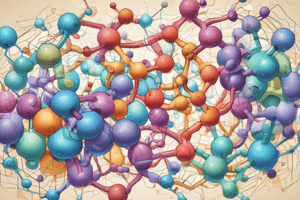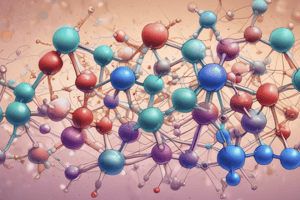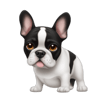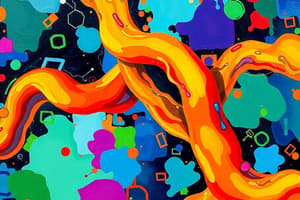Podcast
Questions and Answers
Which aspect of peptide bond formation is critical in determining the acid-base behavior of peptides?
Which aspect of peptide bond formation is critical in determining the acid-base behavior of peptides?
- The total number of peptide bonds
- The type of secondary structures formed
- The presence of only one free amino group
- The characteristics of R groups in amino acids (correct)
What initiates the formation of a peptide bond between two amino acids?
What initiates the formation of a peptide bond between two amino acids?
- The presence of hydrogen bonds
- Ionization of the carboxyl group
- Covalent bonds between R groups
- Loss of water molecules (correct)
What is a characteristic of zwitterions in amino acids?
What is a characteristic of zwitterions in amino acids?
- They do not ionize in water
- They only form in the presence of a non-polar solvent
- They can only exist at high pH levels
- They contain both positive and negative charges (correct)
When predicting the overall acid-base behavior of a peptide, which component is least relevant?
When predicting the overall acid-base behavior of a peptide, which component is least relevant?
How does the average molecular weight of amino acids influence the approximation of amino acid residues in a protein?
How does the average molecular weight of amino acids influence the approximation of amino acid residues in a protein?
What is one function of the prosthetic group in a conjugated protein?
What is one function of the prosthetic group in a conjugated protein?
Which of the following statements about the sequence of amino acids in a peptide is correct?
Which of the following statements about the sequence of amino acids in a peptide is correct?
What is the primary role of proteins in cells?
What is the primary role of proteins in cells?
Which amino acid is the first to be discovered?
Which amino acid is the first to be discovered?
What structural feature do all 20 common amino acids share?
What structural feature do all 20 common amino acids share?
What is the stereochemical configuration of amino acids found in proteins?
What is the stereochemical configuration of amino acids found in proteins?
What type of bond connects amino acids in a protein?
What type of bond connects amino acids in a protein?
Which statement best describes the zwitterionic form of amino acids?
Which statement best describes the zwitterionic form of amino acids?
Which of the following amino acids is an exception regarding the structure at the alpha carbon?
Which of the following amino acids is an exception regarding the structure at the alpha carbon?
What type of chemistry primarily governs the reactions involved in peptide bond formation?
What type of chemistry primarily governs the reactions involved in peptide bond formation?
What is the significance of the isoelectric point (pI) in relation to amino acids?
What is the significance of the isoelectric point (pI) in relation to amino acids?
How do amino acids behave at pH levels above their isoelectric point?
How do amino acids behave at pH levels above their isoelectric point?
Which statement accurately describes the formation of a peptide bond?
Which statement accurately describes the formation of a peptide bond?
What characterizes the titration curves of peptides?
What characterizes the titration curves of peptides?
What is the molecular weight threshold that typically differentiates polypeptides from proteins?
What is the molecular weight threshold that typically differentiates polypeptides from proteins?
Which of the following best describes the nature of zwitterions in amino acids?
Which of the following best describes the nature of zwitterions in amino acids?
Which of the following statements about amino groups in amino acids is true?
Which of the following statements about amino groups in amino acids is true?
During the process of titration, what happens specifically to glycine at its pI?
During the process of titration, what happens specifically to glycine at its pI?
Flashcards are hidden until you start studying
Study Notes
Amino Acid Structure and Bonding
- Amino acids are the building blocks of proteins.
- Peptide bond: A covalent bond that joins amino acids together. It forms by the loss of water when the carboxyl group of one amino acid reacts with the amino group of another.
- Amino-terminal residue: The amino acid at the beginning of the peptide chain with a free amino group. It is conventionally placed on the left.
- Carboxyl-terminal residue: The amino acid at the end of the peptide chain with a free carboxyl group.
Peptide Properties
- Ionization: Peptides have one free amino group and one free carboxyl group at opposite ends. These groups can ionize, contributing to the peptide's overall acid-base properties.
- Non-terminal amino acids: These amino acids are covalently linked by peptide bonds, which do not ionize.
- R group ionization: The R groups of some amino acids can ionize and contribute to the peptide's overall acid-base behavior.
- Acid-base behavior: A peptide's acid-base characteristics are determined by its free amino and carboxyl groups, as well as the nature and number of its ionizable R groups.
Protein Structure
- Amino acid composition: The 20 common amino acids rarely occur in equal amounts within a protein. Some might be present only once or not at all, while others might appear in large numbers.
- Conjugated proteins: These proteins have a non-amino acid part called a prosthetic group.
- Simple proteins: These proteins are composed only of amino acids.
- Complex proteins: These proteins contain both amino acids and a prosthetic group.
Peptides with Biological Activity
- Oligopeptides: Small peptides with important biological activity.
- Examples: Insulin (51 amino acids), glucagon (29 amino acids), vasopressin (9 amino acids), oxytocin (9 amino acids), thyroid releasing hormone (3 amino acids).
Determining the Number of Amino Acids in a Protein
- Divide the protein's molecular weight by 110.
- Reason: The average molecular weight of the 20 common amino acids is about 138.
Amino Acid Titration Curves
- Titration curve: A graph that shows the change in pH of a solution as an acid or base is added.
- Isoelectric point (pI): The pH at which the net electric charge of an amino acid is zero.
- Glycine: Glycine has a net negative charge above its pI, and a net positive charge below its pI.
Polypeptides and Proteins
- Dipeptide: Two amino acids joined by a peptide bond.
- Oligopeptide: A short chain of amino acids.
- Polypeptide: A long chain of amino acids.
- Protein: A large polypeptide with a complex three-dimensional structure.
- Amino-terminal residue: The residue at the beginning of the peptide chain.
- Carboxyl-terminal residue: The residue at the end of the peptide chain.
- Titration curves: Peptides have characteristic titration curves due to their ionizable groups.
General Overview of Proteins
- Proteins are the most abundant biological macromolecules, found in all cells and parts of cells.
- They are the final products of the information pathways of DNA transcription and RNA translation.
- They carry out a wide variety of functions within the cell.
- Proteins are polymers of amino acids, linked by peptide bonds.
Studying That Suits You
Use AI to generate personalized quizzes and flashcards to suit your learning preferences.





